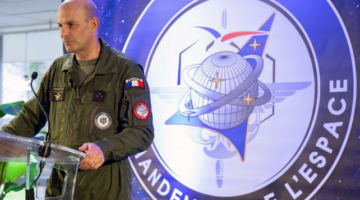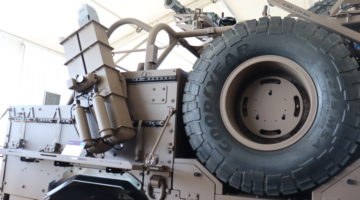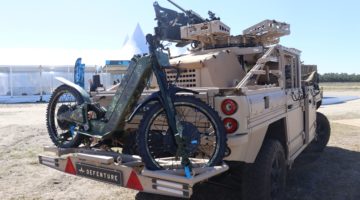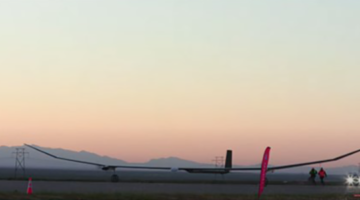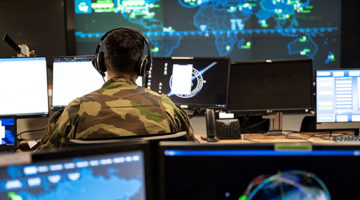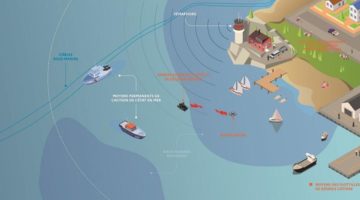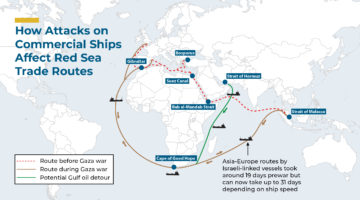In an interview conducted with the Captain of the new Gerald R. Ford, or CVN 78, on January 9, 2015 at the shipyard, Second Line of Defense discussed how the new carrier is different from its predecessor, the Nimitz class.
The upshot of the interview and visit abroad the ship is clear.
CVN 78 is built to provide an infrastructure for evolving warfighting capabilities and concepts of operations, not just for the U.S. Navy, but for the joint and coalition force as well.
The ship is designed to operate more effectively with an evolving airwing, which will change over the 50-year plus life of the carrier.
Question: The new launch and recovery systems coupled with the new weapons handling systems will give you significant flexibility as the air wing evolves.
Could you give us your perspective on this?
Captain Meier: The EMALs system we will visit on board the ship and will allow us to provide for an ability to launch aircraft more smoothly and with less wear and tear on the airplanes and the pilots.
Coupled with the new advanced arresting gear, we will be able to launch and recover a variety of types of aircraft, including future designs that haven’t been developed.
What the arresting gear and the catapult do is they give you better energy absorption, meaning you can launch heavier, faster aircraft than are on the drawing boards today.
You can also launch and recover lighter aircraft than currently fielded.. The legacy landing systems are essentially at their limits in terms of weights of aircraft and maintainability.”
Question: What you’re basically saying is the Navy is enhancing its ability to be able to launch different types of aircraft because you’re not constrained by a catapult system that has to be resized for each aircraft coming out of the launch.
So you can mix and match packages appropriate to mission set.
Could you comment on this development?
Captain Meier: Your point is absolutely right on.
That also goes to not just launch and recovery of aircraft, but the types of ordinance that’ll be happening 30, 40, 50 years from now as well will change dramatically.
We anticipate directed energy weapons being onboard the ship, and a significant evolution of the weapons carried by the carrier.
The new weapons handling system is designed to be able to handle the weapons of the future as well.
You have a great capacity for diversity of weapons, and the advanced weapon elevators themselves are located on the ship to facilitate faster movement and loading of the weapons. That’s the underlying principle of the advanced weapon elevators.
The elevators carry more weight and they go faster, twice the speed and twice the weight essentially of the legacy weapons elevators.
They’re located in the flight deck, which puts them positionally where the crew will spend a lot less time from an ergonomics perspective pushing the ordnance around.
The ordnance comes up right near the aircraft and facilitates more efficient weapons loading.
Question: Could you discuss the power generation capability of the ship and its impacts?
Captain Meier: We’ve got three times the electrical power generated onboard Ford compared to Nimitz. Nimitz is pretty much at the edge of her envelope for available electrical energy.
We’ve got tons of room for growth.
We have excess power, the excess electrical capacity for weapons systems that we don’t know about yet like lasers, direct energies, all those sorts of things are in the art of the possible in the period ahead.
Question: The power generation and cooling, and the computer-based capabilities of the ship coupled with the new radars clearly create a foundation for the evolution of C2.
But what is not widely realized, and we certainly did not before coming onboard the ship, is the impact of what you call flexible infrastructure.
Could you explain what this is and what its impact might well be?
Captain Meier: Flexible infrastructure is a part of the ship built with reconfigurable work areas. Imagine this part of the ship as offices with movable walls where you could set up workspaces how you want them to operate for the task. And you have electrical power in this space to use as you wish.
These spaces can be configured appropriate to a particular C2 scenario whether for the USN, the joint or coalition force onboard the ship.
Question: This ship is built with 21st century engineering, design and manufacturing tools.
Obviously, first of class is always more expensive than what later members of the class cost, and with the Ford when the first is built you have the design tools in place as well.
Could you comment on how one should look at the use of the new design and manufacturing tools to create the USS Gerald R. Ford?
Captain Meier: The manufacturing changes are substantial. When we talk about modeling and simulation, we have a simulator, which can model, down to the level of people walking across the flight deck, whether it’s moving ordnance or aircraft.
That’s the level of detail that we have in some of that modeling. One of the other great products of the ship has developed and the Navy’s purchased is the 3D model which is essentially designed in a computer to provide a complete 3D model of the ship and its operations.
So you could in the computer design even with 3D goggles.
You can move assets around to determine where best to place it or better position it.
There are many components or large sized components that may need to be removed so, from a design perspective, a ship has designed removable paths and you can do all of that.
The models will also be used to drive change plans down the road. And they are also important in doing maintenance on the ships.
Question: Clearly, the ship has a lot of up front design and infrastructure built in to make it a more cost effective ship to operate from a maintenance point of view. Could you give us a sense of the importance of this build-into the ship?
Captain Meier: By design there are fewer components and the components that we have are generally designed for the life of the ship.
Many of the components here will last the life of the ship.
The design of having fewer components and more robustly designed components clearly will enhance maintainability.
And with other changes built into the ship, we will reduce the required crew size as well, with 700 fewer Sailors being required to operate an even more complex warship than the Nimitz.
This would not have been possible without 21st century design and manufacturing techniques.
For the complete article see the following:
http://www.sldinfo.com/the-arrival-of-the-cvn-78-the-ships-captain-talks-about-the-way-ahead/
And for additional pieces on Second Line of Defense see the following as well:
http://www.sldinfo.com/crafting-the-gerald-r-ford-flight-deck-enlarging-the-operational-space/
http://www.sldinfo.com/shaping-flexible-c2-at-sea-the-role-of-flexible-infrastructure/
http://www.sldinfo.com/the-second-line-of-defense-visit-to-the-uss-gerald-ford/


